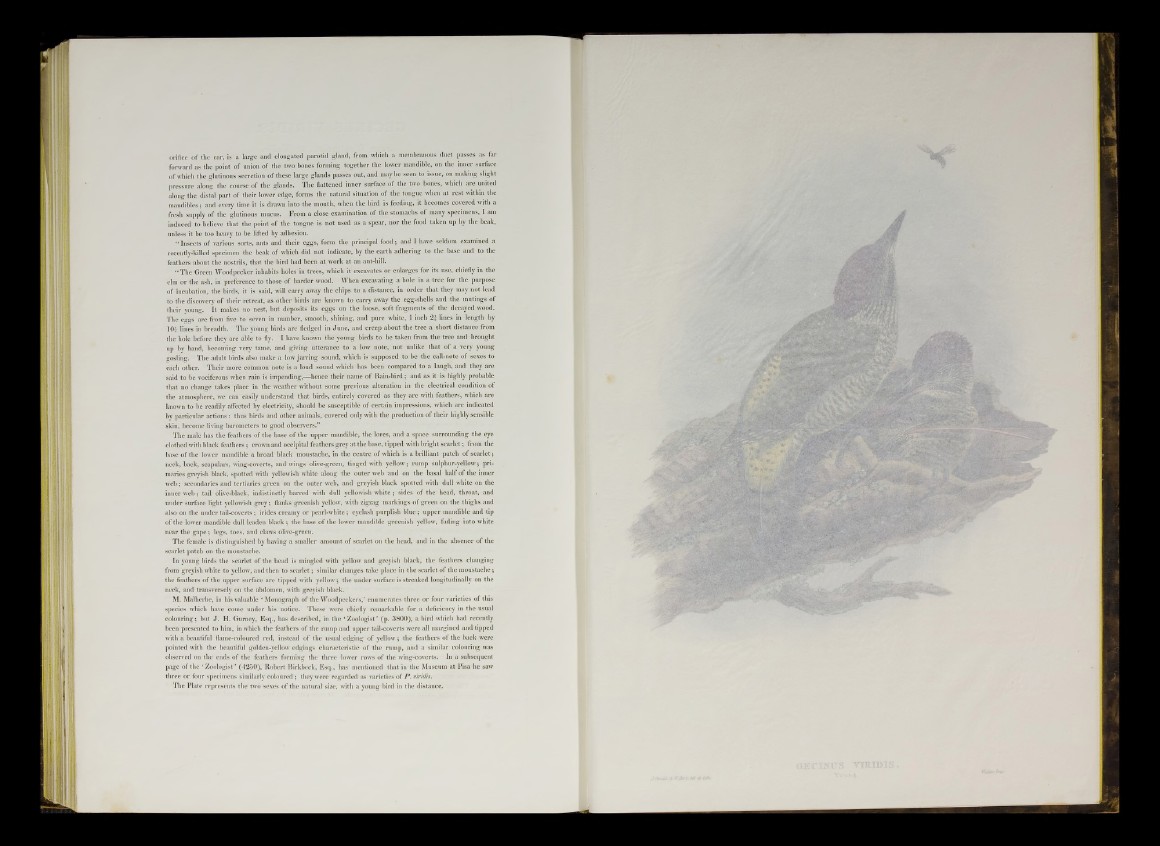
orifice of the ear, is a large and elongated parotid gland, from which a membranous duct passes as fcir
forward as the point of union of the two bones forming together the lower mandible, on the inner surface
of which the glutinous secretion of these large glands passes out, and may he seen to issue, on making slight
pressure along the course of the glands. The flattened inner surface of the two bones, which are united
along the distal part of their lower edge, forms the natural situation of the tongue when at rest within the
mandibles; and every time it is drawn into the mouth, when the bird is feeding, it becomes covered with a
fresh supply of the glutinous mucus. From a close examination of the stomachs of many specimens, 1 am
induced to believe that the point of the tongue is not used as a spear, nor the food taken up by the beak,
unless it be too heavy to be lifted by adhesion.
“ Insects of various sorts, ants and their eggs, form the principal food; and I have seldom examined a
recently-killed specimen the beak of which did not indicate, by the earth adhering to the base and to the
feathers about the nostrils, that the bird had been at work at an ant-hill.
“ The Green Woodpecker inhabits holes in trees, which it excavates or enlarges for its use, chiefly in the
elm or the ash, in preference to those of harder wood. When excavating a hole in a tree for the purpose
of incubation, the birds, it is said, will carry away the chips to a distance, in order that they may not lead
to the discovery of their retreat, as other birds are known to carry away the egg-shells and the mutings of
their young. It makes no nest, but deposits its eggs on the loose, soft fragments of the decayed wood.
The eo-gs are from five to seven in number, smooth, shining, and pure white, 1 inch 2 ! lines in length by
] 0 | lines in breadth. The young birds are fledged in June, and creep about the tree a short distance from
the hole before they are able to fly. I have known the young birds to be taken from the tree and brought
up by hand, becoming very tame, and giving utterance to a low note, not unlike that of a very young
gosling. The adult birds also make a low jarring sound, which is supposed to be the call-note of sexes to
each other. Their more common note is a loud sound which has been compared to a laugh, and they are
said to be vociferous when rain is impending,—hence their name of Rain-bird; and as it is highly probable
that no change takes place in the weather without some previous alteration in the electrical condition of
the atmosphere, we can easily understand that birds, entirely covered as they are with feathers, which are
known to he readily affected by electricity, should be susceptible of certain impressions, which are indicated
by particular actions: thus birds and other animals, covered only with the production of their highly sensible
skin, become living barometers to good observers.”
The male has the feathers of the base of the upper mandible, the lores, and a space surrounding the eye
clothed with black feathers; crown and occipital feathers grey at the base, tipped with bright scarlet; from the
base of the lower mandible a broad black moustache, in the centre of which is a brilliant patch of scarlet;
neck, back, scapulars, wing-coverts, and wings olive-green, tinged with yellow; rump sulphur-yellow; primaries
greyish black, spotted with yellowish white along the outer web and on the basal half of the inner
web; secondaries and tertiaries green on the outer web, and greyish black spotted with dull white on the
inner web; tail olive-black, indistinctly barred with dull yellowish white; sides of the head, throat, and
under surface light yellowish grey; flanks greenish yellow, with zigzag markings of green on the thighs and
also on the under tail-coverts; irides creamy or pearl-white; eyelash purplish blue; upper mandible and tip
of the lower mandible dull leaden black ; the base of the lower mandible greenish yellow, fading into white
near the gape; legs, toes, and claws olive-green.
The female is distinguished by having a smaller amount of scarlet on the head, and in the absence of the
scarlet patch on the moustache.
In young birds the scarlet of the head is mingled with yellow and greyish black, the feathers changing
from greyish white to yellow, and then to scarlet; similar changes take place in the scarlet of the moustache;
the feathers of the upper surface are tipped with yellow; the under surface is streaked longitudinally on the
neck, and transversely on the abdomen, with greyish black.
M. Malherbe, in his valuable ‘ Monograph of the Woodpeckers,’ enumerates three or four varieties of this
species which have come under his notice. These were chiefly remarkable for a deficiency in the usual
colouring; but J. H. Gurney, Esq., has described, in the ‘Zoologist’ (p. 3800), a bird which had recently
been presented to him, in which the feathers of the rump and upper tail-coverts were all margined and tipped
with a beautiful flame-coloured red, instead of the usual edging of yellow; the feathers of the hack were
pointed with the beautiful golden-yellow edgings characteristic of the rump, and a similar colouring was
observed on the ends of the feathers forming the three lower rows of the wing-coverts. In a subsequent
page of the ‘ Zoologist ’ (4250), Robert Birkbeck, Esq., has mentioned that in the Museum at Pisa he saw
three or four specimens similarly coloured ; they were regarded as varieties of P. viridis.
The Plate represents the two sexes of the natural size, with a young bird in the distance.